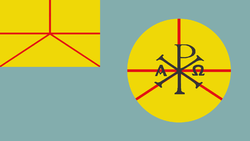Imperial Air Force
| Austenasian Air Force | |
|---|---|

| |
| Established | 11 October 2009 (first) 28 January 2012 (second) |
| Country | Empire of Austenasia |
| Leadership | |
| Marshal of the Imperial Air Force | HIM Emperor Jonathan I |
| Chief of Air Staff | Marshal Sir Ash Mitchell, KPP |
| General information | |
| Headquarters | None official |
| Personnel | 6 |
| Standard weapon | TBD |
The Imperial Air Force (IAF) was the aerial warfare branch of the Austenasian Armed Forces, the national military of the Empire of Austenasia.
History
The Imperial Air Force was established on 11 October 2009, but apart from a few secret weapon tests the original iteration of the IAF never really contributed to the defence of Austenasia. The IAF was disestablished on 8 March 2010 and its functions transferred to the Austenasian Army, although the Monarch retained the ceremonial title Air Chief Marshal of the Imperial Air Force.
In September 2010, Zephyria was given permission to found its own local air force, subject to regular inspection by the central government. This was officially founded by Lord Marshal William on 19 December 2010 in response to the Fall of Wrythe.
On 28 January 2012, the Imperial Air Force was properly re-established with the passing of the Imperial Air Force Act 2012, with Sir Ash Mitchell (formerly known as Micheal Mitchell, also a tribune in the Austenasian Army) leading it as Air Chief Marshal. Lord Marshal William's "Imperial Air Force" renamed itself to the "Zephyrian Air Force" in response before merging with the IAF on 28 April 2014. The IAF was dissolved on 17 June 2020, by which point its members had lost contact with the imperial government.
Aircraft
The Imperial Air Force had two remote-controlled helicopters (one of which was a reconnaissance helicopter with a high-definition camera) and a remote-controlled plane. A design for an observation balloon, the Ascension-class, was successfully tested in February 2013, but only one (now deflated) was built.
Command structure
Although overseen and funded by the Ministry of Defence, the IAF fell under the command of the Chief of Air Staff. Although the Chief of Air Staff had almost total administrative control, he was appointed by and accountable to the War Council and so the IAF was ultimately directed by them during wartime. The IAF used the following hierarchy of ranks:
Officers
- AO-7 Marshal
- AO-6 Vice Marshal
- AO-5 Air Commodore
- AO-4 Group Captain
- AO-3 Wing Commander
- AO-2 Squadron Leader
- AO-1 Flight Lieutenant
Enlisted
- AE-5 Chief Master Sergeant
- AE-4 Master Sergeant
- AE-3 Staff Sergeant
- AE-2 Airman First Class
- AE-1 Airman Apprentice